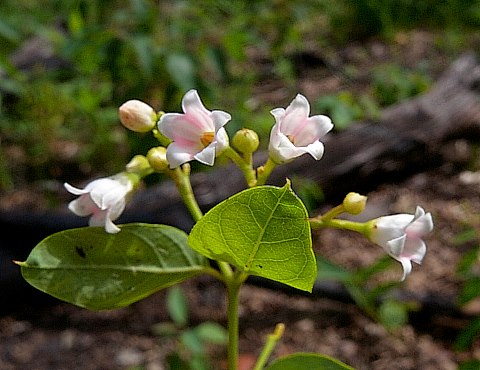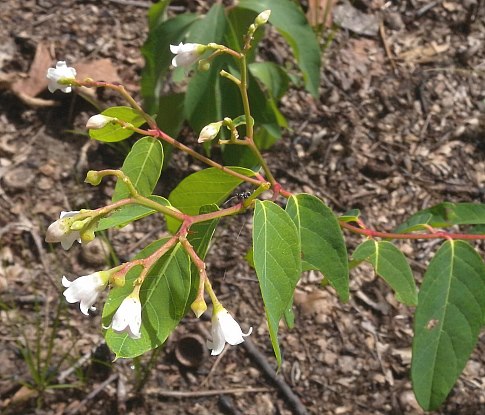
The slightly nodding flowers are produced in terminal cymes (flat-headed panicles) spanning 1-4" across. Individual flowers are about 1/3" (8-9 mm.) long and about the same length across; each flower has a white to pink bell-shaped corolla with 5 spreading to recurved lobes, a small light green calyx with 5 teeth, 5 stamens, and 2 pistils. The stamens form a cone over the merged stigmata of the pistils. There are also 5 nectaries between the bases of the stamens. The interior of the corolla has 5 thick pink stripes that lead to the nectaries. The peduncles and pedicels of the cymes are light green to red and glabrous; individual pedicels are less than 1/3" long. The blooming period occurs during the summer for 1-2 months. There is a sweet floral fragrance. Flowers that have been successfully cross-pollinated
Cultivation: The preference is partial sun, mesic to dry conditions, and a somewhat barren soil that is sandy or rocky. Spreading Dogbane tolerates other kinds of habitats, but it tends to be less competitive with other plants.
Range & Habitat: The native Spreading Dogbane is occasional in most areas of the state; it is slightly more common in the northern section of the state than elsewhere. Habitats include upland prairies, sand prairies, sandy savannas, stabilized sand dunes near Lake Michigan, thin sandy woodlands, thinly wooded rocky bluffs, and abandoned sandy fields. Spreading Dogbane tends to be particularly common in areas that are burned over from wildfires. In wooded areas, it is typically found in association with oak trees.
Faunal Associations: The flowers are cross-pollinated primarily by small bees (particularly Halictid bees) and miscellaneous flies. The floral reward of these visitors is nectar. Other insects feed on the foliage, plant juices, and other parts of Spreading Dogbane. These species include Chrysochus auratus (Dogbane Beetle) and Tetraopes tetrophthalmus (Red Milkweed Beetle); they also include caterpillars of the moths Cycnia oregonensis (Oregon Cycnia), Cycnia tenera (Delicate Cycnia), Papaipema baptisiae (Wild Indigo Borer Moth), and Spargaloma sexpunctata (Six-Spotted Gray). Hottes & Frison (1931) observed the following aphids feeding on one or more Apocynum spp. (Dogbanes): Aphis asclepiadis, Aphis citricola, and Macrosiphum gei. The last two aphid species are highly polyphagous. Because the white latex of the foliage is acrid and toxic, mammalian herbivores rarely bother Spreading Dogbane.
Photographic Location: A stabilized sand dune near Lake Michigan at Indiana Dunes State Park in NW Indiana. The dominant vegetation of this sand dune consisted of oak trees.

Comments: Spreading Dogbane is a rather lanky plant with small fragrant flowers. It is less aggressive (at least in Illinois) than the closely related Apocynum cannabinum (Common Dogbane). This latter plant refers wetter habitats than Spreading Dogbane. These two species are similar to each other in appearance, but Spreading Dogbane can be distinguished as follows: 1) it tends to be a shorter and more widely spreading plant than Common Dogbane, 2) its flowers are slightly larger in size and the lobes of its corollas are more widely spreading or recurved, and 3) its flowers have conspicuous pink stripes along the sides of the corolla's interior.